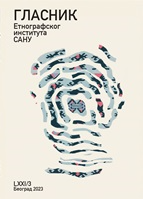The Role of Women in the Production and Distribution of Series in Yugoslavia – Creators of Socialist Cultural Heritage
The Role of Women in the Production and Distribution of Series in Yugoslavia – Creators of Socialist Cultural Heritage
Author(s): Ilija Ž. Milosavljević, Ivana Ercegovac, ANNA CARROLLSubject(s): Cultural history, Museology & Heritage Studies, Media studies, Political history, Social history
Published by: Етнографски институт САНУ
Keywords: television series; women; socialism; Yugoslavia; cultural heritage;
Summary/Abstract: The paper deals with the research of the presence and roles of women in the creation of series in socialist Yugoslavia during the sixties and seventies of the 20th century. Besides the primary objective of identification, this study aims to identify specific patterns in work allocation, highlight significant female contributors, and underscore their contributions to the development of television series, thereby shedding light on values, cultural patterns, and societal practices. Also, Cultural Identity Theory was implemented to provide a valuable framework for understanding how women’s contributions behind the scenes in Yugoslav television series production during the 1960s and 1970s are intricately linked to the construction of cultural identity. Further, the paper analyzes the list of employees involved in the creation of 17 Yugoslav series created during the 1960s and 1970s. All information about the employees was found on the site IMDB.com. With the help of a specially constructed code list, they were listed and classified, and descriptive and comparative statistics of data analysis were carried out in the SPSS 24.0 program. In the second part of the analysis, the most significant women in this process were singled out and presented. The results clearly demonstrate that women held significantly fewer positions than men, with a distinct division of labor based on gender roles. Men are more often those who relate to the main positions in making series, and women to logistics and aesthetics of the characters. Also, the conclusion of the research is that, in order to be successful, a woman in that period often had to be supported by a man, but that, when she was recognized, she played a significant role in many projects, thus participating in defining the cultural heritage of an entire era.
Journal: Гласник Етнографског института САНУ
- Issue Year: LXXI/2023
- Issue No: 3
- Page Range: 65-84
- Page Count: 20
- Language: English

